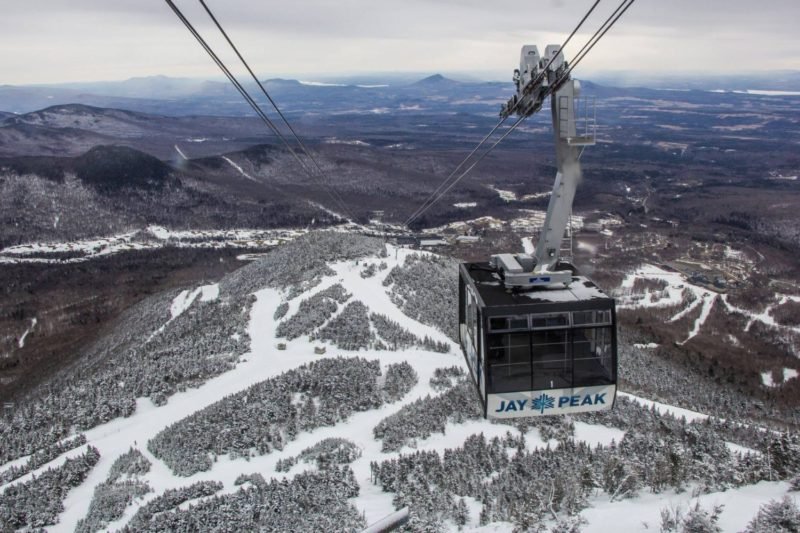Resilience Case Study: How Jay Peak Grew Through Challenge
From time to time, we will share our most popular content. This blog, from 2021, was written as part of my research into what makes organizations resilient. Learning about Jay Peak, meeting GM Steve Wright, and visiting the mountain resort became a catalyst for writing my book Reinventing Resilience.
In a remote corner of Vermont, the faces of Jay Peak resort employees adorn banners, placards, and posters across a sprawling campus. It’s a brilliant, modern branding strategy that taps into consumers’ affinity for conscious companies that respect their workers. But, at Jay Peak, it’s way more than just a marketing campaign for woke skiers or an attempt to placate workers, the faces tell a deeper story of a resilient company that meets challenges and grows through tough times.
As part of my research for my book, Reinventing Resilience, I spoke with General Manager Steve Wright who shared the inspiring backstory of Jay Peak Resort - an organization that found its strength to grow through very challenging times.
The Situation - Normal No More
By 2012, the resort had been aggressively growing for about 10 years. It added hundreds of hotel rooms, a golf course, new chair lifts, and other infrastructure to attract guests from the United States, Canada, and around the world in order to compete in the notoriously challenging ski industry. Other big projects like upgrading the high-speed tram to the peak in order to improve the skier experience were scheduled. The rapid growth was financed mainly by foreign investors leveraging the U.S. Government’s EB-5 Immigrant Investment Visa Program - designed to spur economic growth by allowing foreign investment in exchange for a speedier pathway to obtaining U.S. residency status. It spawned national security and fraud concerns from Sen. Charles Grassley (R-IA), the Securities and Exchange Commission, and others. While there were many EB-5 fraud cases across the United States, the Jay Peak case ultimately became the most well-known.
On April 13th, 2016, at 12:40 p.m., the SEC arrived in black SUVs to suspend resort operations and begin investigating alleged fraud. Investigators fanned out to the offices, told employees to step away from their computers, and began seizing records. In the few minutes it took them to grab control, Jay Peak’s version of normal changed forever.
The Triggers - Organizational Fight, Flight, Freeze Mode
Steve Wright talks in vivid detail about the afternoon of April 13th. The memories are forever embedded in his brain’s neural pathways. One moment he is grousing about picking up his daughter’s boyfriend and driving him to her track meet. The next moment, he’s got a Federal agent telling him to go back inside, cancel his plans, and keep his hands where they can see them. After a cursory look at the organization chart, the investigator said to Wright, “OK, you’re now in charge.”
People react to threats (fight, flee, or freeze) when they believe they’re in danger. When a threat happens at the organizational level the way it did at Jay Peak, collective fear of an unknown future can quickly lead to chaos. Steve Wright and his team had to act fast to keep everyone confident about Jay Peak as a viable business. They did that in two ways: first, they protected revenue any way they could. For example, Wright flew to Washington to rescue a booked 1,000-person convention and $1M in top-line earnings. He also spoke with dozens of brides and their families who booked wedding receptions to let them know the resort would be there for their special days.
Second, Wright protected the people working at the resort. As an executive, he had access to information about the investigation. But he thought of those with almost no visibility into the situation: the lift attendants, folks working in the coffee shops, and even those in the community. He knew that people would start freaking out if he stayed silent or operated in reactive mode. So, his approach was to get “as much information out as widely and quickly as humanly possible and have it be as honest and transparent as the federal government will allow.” In doing this, Wright shone a light on the situation instead of avoiding it. This act of openness proved fateful. A mass exodus was avoided and a glimmer of hope remained.
Resources - Deeper Than a Vermont Snowdrift
Resilient people and organizations access resources they have at their disposal. Jay Peak’s trusting culture is among its most valuable resources. Wright says Jay Peak’s early days as a small resort full of friendly, loyal employees who genuinely cared for each other created a solid foundation. Wright describes the “deep, deep, deep love of Jay. There's a generational love for Jay with employees and their kids and their kids’ kids and grandparents, all working here.” The previous General Manager made it a point to be accessible to employees at all levels. He would clear tables in the dining areas, “bump” ski lift chairs, and be visible and accessible to all. Today, Wright often does the same.
Many organizations facing huge setbacks often feel helpless. Imagine the Federal government rolling in to take over your business. You might feel overwhelmed and powerless to do much besides comply. Wright is the first to admit that was a tough moment. But, Wright and the Jay Peak team soon moved beyond the initial shock, acknowledged the reality of the situation, and found something over which they had some agency: the people at Jay Peak. This helped employees suspend judgment during the SEC investigation long enough to see the hope being created.
Possibilities - Landing in a New Normal
Jay Peak’s setback could have ended in the company’s demise. But, the company’s collective resilience enabled it not only to survive but to grow through challenging times. Returning to “normal” was never going to happen, and in many respects Jay Peak has leap-frogged its pre-EB5 state and transformed into a new, different, and better organization. 90% of brides decided to keep their wedding receptions at Jay Peak that year, and that business has expanded over the years. The major tram project was completed and skiers now have a faster and more comfortable way to the summit. The conference business - once so important to survival - is now thriving. Other improvements like the year-round water park, movie theater, indoor climbing wall, upgraded restaurants, a nordic ski center, and hockey rink continuously attract both local and traveling guests.
From EB-5 to COVID-19
Looking at the employees’ faces on the banners, placards, and posters hanging in the indoor and outdoor common areas, we see the source of Jay Peak’s resilience hiding in plain sight. Circumstances change, setbacks happen, headwinds blow. Jay Peak has been able to meet its challenges because of the organizational and cultural strength it’s built up over time. Resilience can’t be learned in the moment. “There isn’t any time for long thoughts when you’re in [a difficult] moment,” Wright says. “You’re just responding to the hottest fire that’s closest to your face.”
Fast forward to 2020, the COVID-19 pandemic took everyone by surprise, including Jay Peak. Another setback. Another difficult valley to cross. The culture once again kicked into gear and - even though state and federal travel and lodging guidelines changed week to week - the organization looked at the situation with a sense of realism and agency. Once again Jay Peak activated its strengths to meet a major challenge and grow through tough times.




